The Lost Swarm
Posted: Sun Jul 30, 2023 10:11 am
What happens to the swarms lost from the apiary, the ones that got away, on their own without intervention and free to do as they will? Would they survive, could they look after themselves, could they maintain good health, would they prosper? It was always a subject for speculation, would or could they survive on their own, and for how long? All things being equal in a world the way nature intended they certainly would have a very good chance of survival, but in today's world it’s a very different matter, so much of our environment is absolutely not the way nature intended. Their fate we could only imagine, until an opportunity arose to find answers to some of those questions. And find answers we did.
During the spring of 2020 one of our more proliferous colonies threw a prime swarm. Despite our diligence it caught us on the hop, and off it went, which was disappointing but swarming happens, it’s what honeybees do and is an important aspect of their lifecycle. It was lost for good or so we thought until shortly afterwards bees were reported going in and out of a dormer window roof space in a nearby house. Through binoculars we could see busy bees at the roof, gaining access through a small gap in some loose mortar flashing, was this our swarm? There was no way to tell unless it was recovered and that wasn’t likely to happen so we could only observe it with interest as we came and went from the apiary. We marvelled at how well scout bees had performed in discovering and checking out that particular opportunity, about quarter of a mile from our apiary, and how they had convinced the swarm they’d found a suitable home and then persuading the masses to follow to the small entrance.
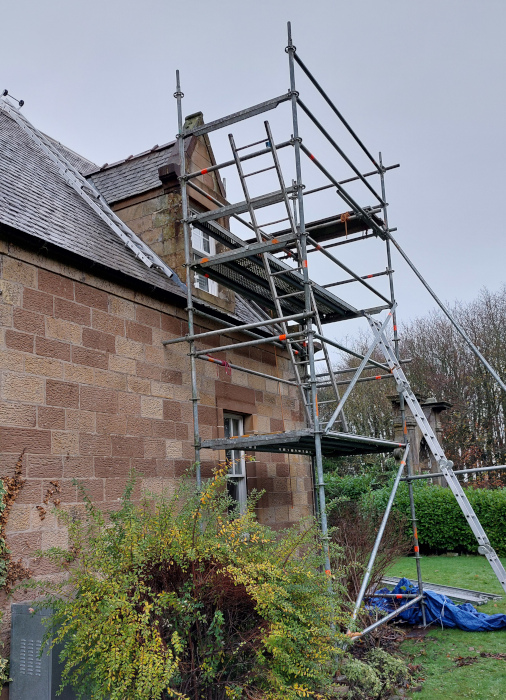
The property owners were not unhappy about having the new residents in the roof space, it was well up, out the way and posed no risk to anyone, they quite liked the idea of the bees choosing their property. However they did point out they were aware of some outstanding roof maintenance work that would need to be carried out sooner or later. So we monitored the roof-space bees regularly over the next two and a half years, as busy as any in our apiary hives, and we kept a swarm trap baited in their garden to catch anything it cast out. Two swarms with unmarked queens were trapped but there was no way to confirm where they were from. During the period, European Foul Brood was confirmed in migratory colonies close by in both 2020 and 2021 requiring all our colonies and apiaries be fully inspected both years, happily without issue. We could only guess at how the now feral colony was faring up in the roof-space. Watching it was intriguing and made us think more about swarms, the when, why and how they contribute to honeybee population dynamics, and just how would a swarm do on it’s own today?
In the natural world swarms spread populations and genetics out to a wider area to cross breed with those from other areas as subsequent healthy virgin queens fly out to mate with unrelated drones ensuring genetic diversity and strength – evolution in action. The parent colonies left behind would face prosperity or demise depending on whether they too had the health, genetic strength, and desirable traits to continue. As we know not all swarms survive, with a lack of suitable natural nest sites such as old trees, buildings or natural cavities, many perish unable to find a suitable new home, or have the queen picked off by a hungry avian, or some other misfortune before finding safety. Then there is the question of how would a swarm, successfully tucked up in a new found nest site, get on surviving particularly with the now endemic Varroa, to which they have no natural defences. The Varroa pest we know doesn’t just come on its own, other pathogens detrimental to honeybees are carried and transferred to the colony by the mites. Could a swarm/feral colony find a way, a resistance or means of keeping the Varroa load to a level they could live with? The plight of feral colonies has always been a bit of mystery.
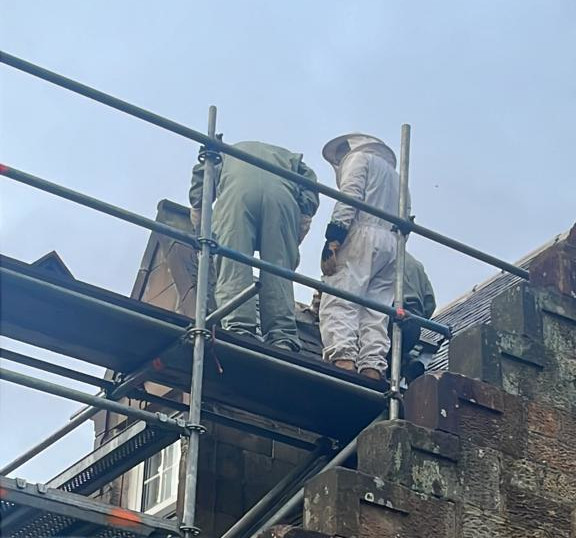
Two and a half years on and the roof repairs eventually became a matter of urgency, it was obvious the bees would have to be removed to facilitate this. The work was discussed and duly planned with the owners and roofers who would be loaned suits and gloves to keep them bee proof during operations. Scaffolding was erected and work began on a cold 5°C dry day in late November 2022 and yes, it would have been better in season when there would have much more of a chance to save the colony, but unfortunately immediate needs and worsening weather drove the necessity. The clay ridge tiles and slates were removed and sarking boards cut away revealing a beautifully constructed nest of triangular combs filling the entire front part of the dormer roof-space, measuring in mm 750 high x 650 wide at the base x 700 long. A quick bit of trig (half the base x height x length) worked it out to be around 170.625 litres in volume, roughly equivalent to 5 National / Smith brood boxes, a sizeable nest, they had been busy little bees. Without delay we worked from the back cutting the combs away from the roof timbers, inspecting them and transferring them to plastic containers. There was no eruption of angry bees, and not as many present as might be expected from such a large nest, they were uncannily pacific which made removal less stressful than it could have been. During the process many bees with signs of Deformed Wing Virus were observed, an indication of poor colony health and of an associated heavy Varroa loading. Several combs of honey were removed before the brood nest was reached at the end nearest and against the outer stonework, not in the middle of the nest as expected.
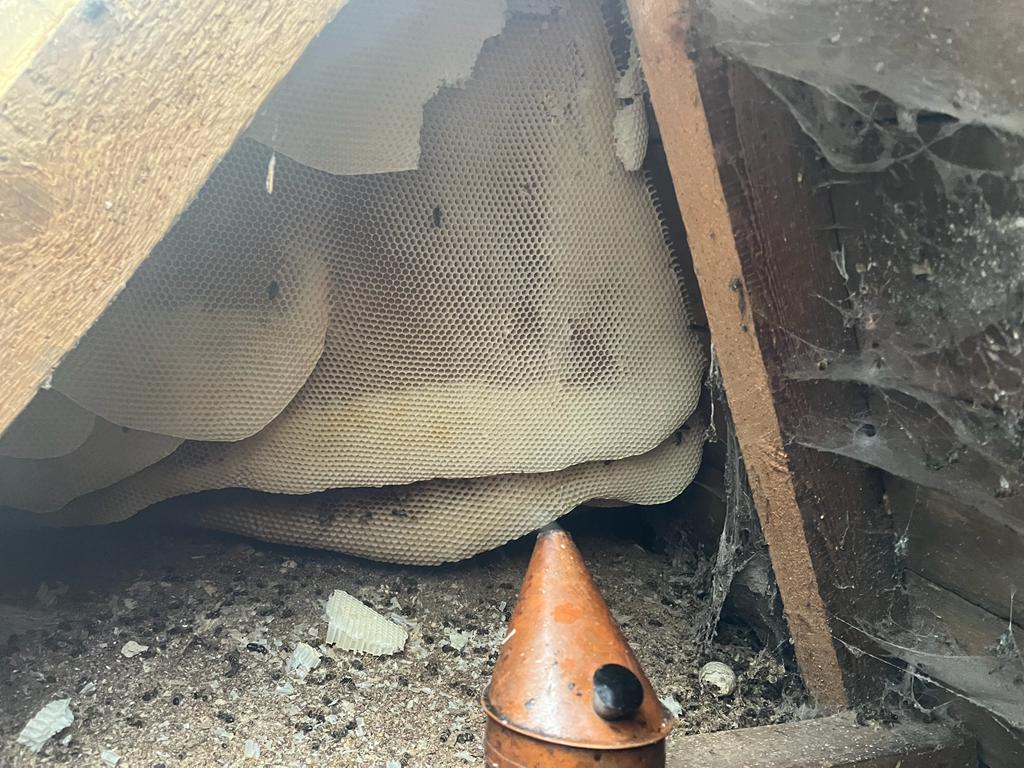
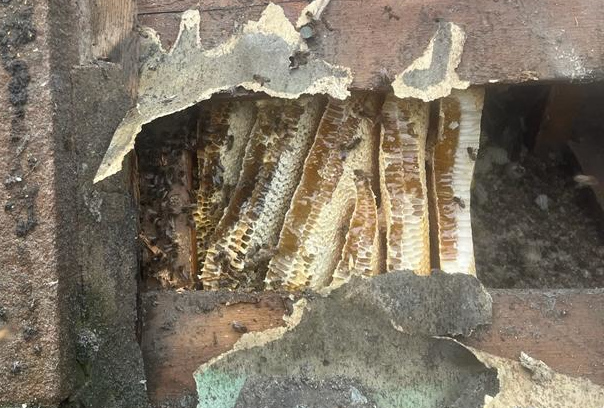
The queen was found and to our great surprise it was our queen, the marking applied some three years previous still just visible. We trapped her in a cage and along with the brood nest combs stored separately in a prepared brood box with floor and roof. This was left undisturbed with an open entrance in situ for around 3 hours over lunch time allowing any flying bees to find and join the queen before the rest of the nest material and debris was removed and the roof repairs commenced. Keeping in mind our biosecurity protocols the entire nest material and remains of the colony were removed at days end to a location away from our main apiaries for later inspection.
The swarm had been feral in the roof for more than 30 months at this point without the health checks or treatments afforded our own apiary bees, consequently we did not expected the colony to be in particularly good health and in the event the strength of the colony turned out to be quite weak even before we dismantled it. On inspection the following day we discovered there were few bees in the brood box and certainly not enough to sustain themselves, the remaining brood, or their queen over the winter. In light of their unknown health status uniting them with another colony was out of the question so the remaining bees, now in a torpid state with the cold, would be collected together and taken along with the remains of the brood nest to SASA (Science and Advice for Scottish Agriculture) at Roddinglaw for detailed examination. We took the opportunity to photograph the remains of the brood nest before passing it and the sample bees on. Meanwhile all our kit was put through the washer to ensure no transfer of unwanted infection.
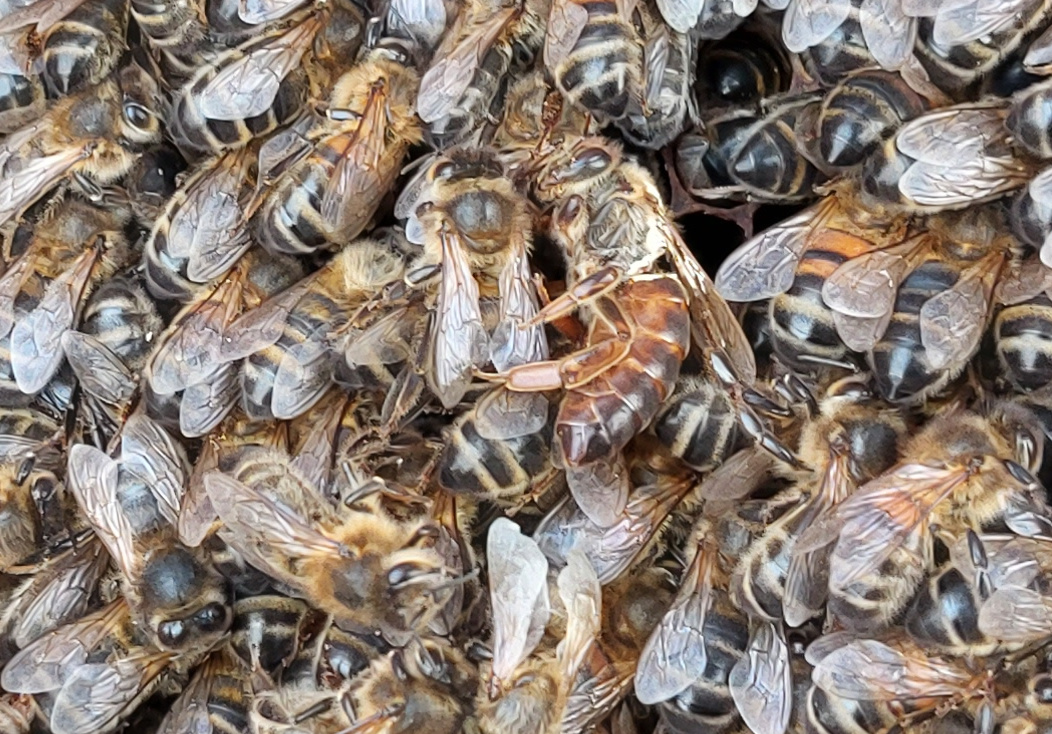
Finding the original queen was a surprise, we knew her to be in her fourth year. We had imagined that a swarmed queen would be weakened or spent by the end of the first year or so and would have been superseded by now, but that was clearly not the case. Our wayward queen was very much there, the vertical eggs in the cells showing that she was in apparent good health and had been laying fresh eggs right up to the day we dismantled the nest. The brood nest itself looked perfectly normal to all intents and purposes with areas of fresh eggs, brood of all stages, normal healthy looking capping over worker brood, evidence of emerging bees, and stores of pollen nearby. There was also a small area of recently capped and normal looking drone brood which was again unexpected considering the time of the year, although no flying or crawling drones were observed.
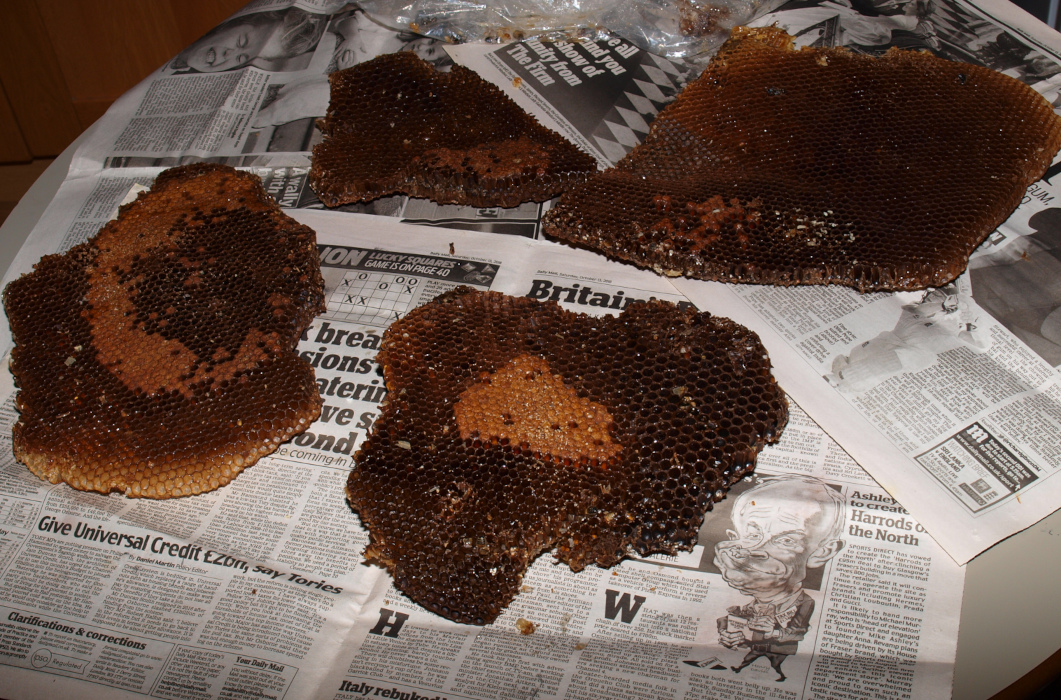
The remains of the brood nest and sample of around 400 bees including the queen were collected together and prepared for transport to the SASA at Roddinglaw. The bees, completely torpid due to the cold, soon recovered in the warmth of the jar and clustered round the queen, a few at the bottom showing signs of Deformed Wing Virus, which was unsurprising as a great many others with the symptoms had been observed while removing the nest, these would not have been able to fly to join the caged queen. Extracting the honey from the recovered combs was a messy business but yielded around 60lbs of blossom honey. There was no OSR evident although there were fields of OSR close by during 2022, another puzzle!
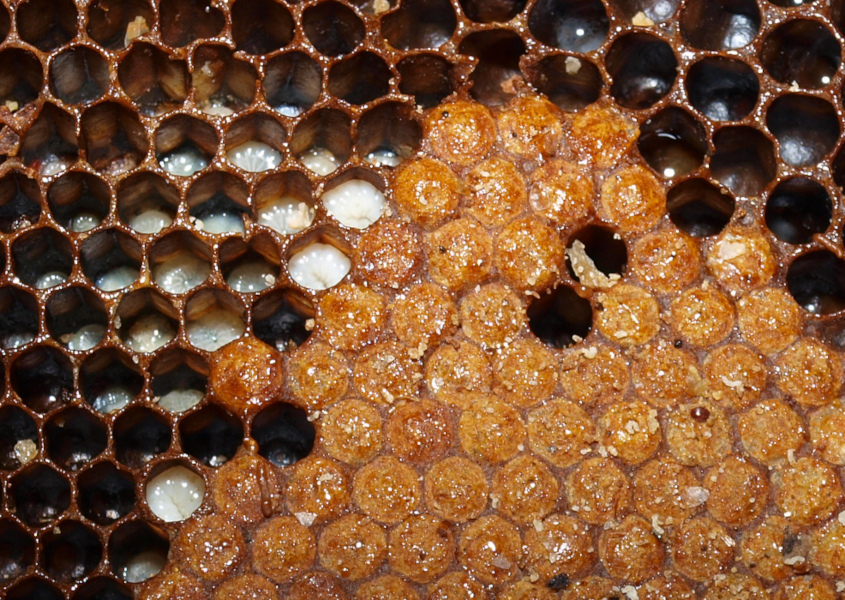
Once the Entomology Department at SASA had the samples 30 individual bees were randomly selected for immediate analysis while a small sub-sample was retained to facilitate further screening for the underlying pathogens of foul brood diseases if and when the resources become available. Test results arrived within the week.
The SASA test results on the comb and sample bees:
Dead Bee results – sample of 30 bees
Foulbrood - nil; Varroa - 3; mites Acarine - nil; Nosema - nil
• Phoretic Mites - the 30 adult bee sample showed 1 mite per 10 bees. The remainder of the 400 bees (approx) when washed however showed a further 88 mites, approx 1 mite per 4.5 bees.
• Drone Cells - the 44 capped drone brood revealed 60% (28/44) of cells infested with Varroa, one larvae hosting as many as 6 mites!
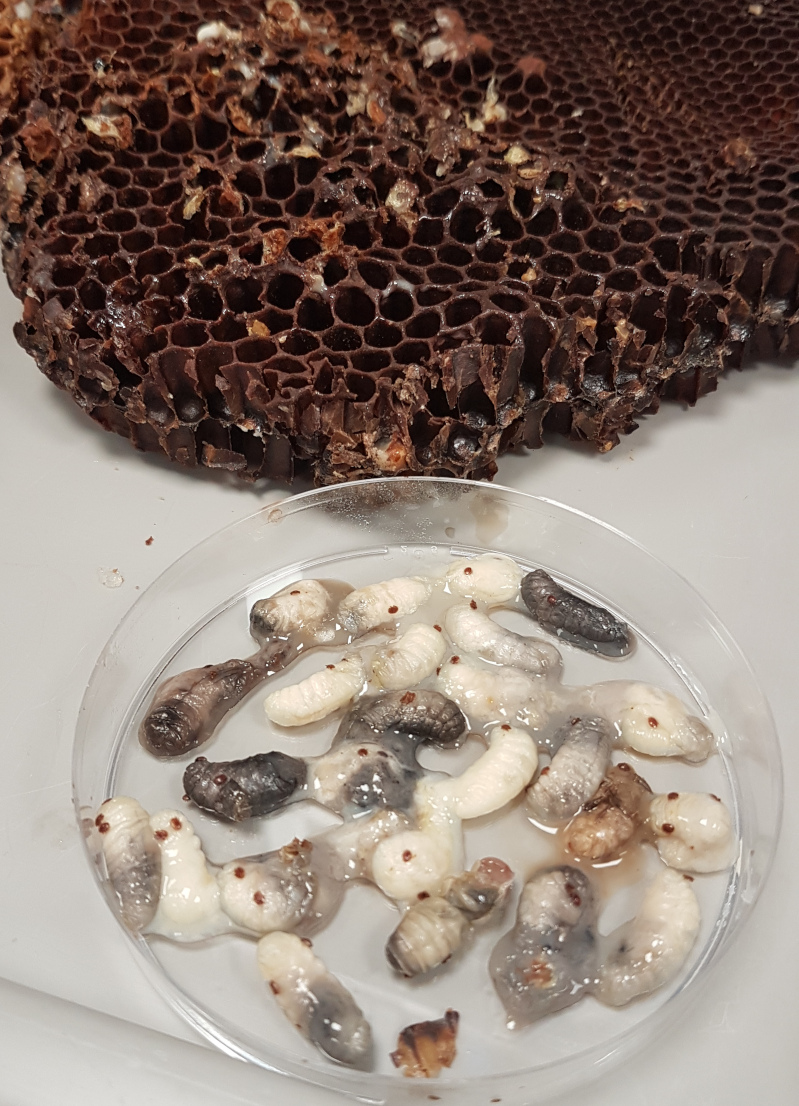
Reviewing our records and findings, and that of SASA, we concluded the swarm, when it left the hive in Spring 2020, had a low Varroa count following autumn and winter treatments. It had made a good start, building a substantial nest and store of honey in the roof-space. The brood nest was built against and out from the stone wall, presumably benefiting from retained heat in the stonework helping maintain steady nest core temperatures, while the honey combs were built above and back into the roof space. The considerable honey stores were mostly sealed but the rearmost while in good condition was as yet unsealed, and unlikely to be sealed at this time of the year in the low temperatures and would probably have fermented as moisture was absorbed. The size and condition of the brood nest, the number of eggs, developing larvae and sealed brood would normally have been associated with a strong colony, however the colony was weak and suffering from a Varroa overload with significant numbers showing Deformed Wing Virus, and it be correct to assume there were many other bees with the virus but without the visible symptoms. They would equally suffer from premature death and greatly reduced colony performance resulting in depleted colony numbers and eventual collapse.
Beyond the Varroa and associated DWV there were no other diseases found which again was surprising in view of the colony’s compromised health and strength which would normally make them vulnerable to disease. What was a healthy prime swarm from a proliferous apiary colony that tried and should have in normal circumstances prospered, had performed well at the start but was now failing and doomed to collapse sooner rather than later. The large feral nest, a weak colony, an old laying (but clearly well mated) queen, a normal looking and still productive brood nest, no evidence of queen cells old or new, and capped drone cells at the end of November, raised more questions not least why was the old queen still there and why were there no subsequent swarms cast? Casting swarms annually would ensure more chances of genetic survival even for a season or two, but there was no evidence. Unusual seasonal weather may account for some of the anomalies, but what was clearly evident, and we were left in no doubt, was that even this large healthy swarm with good genetics and traits had without intervention done it’s best to survive and did so for more than two years but was now, and with absolute certainty, entering the final stages of collapse.
On reflection, our original quest to find out how a lost swarm would cope on its own was answered - it just wouldn’t! It would simply be unable to cope with Varroa and the associated DWV on its own, and would eventually weaken and perish. Our swarm in the dormer was not going to make it to spring, it would collapse through lack of numbers unable to sustain core temperatures and brood production. It’s possible that had it cast subsequent swarms, and had they found suitable nest sites, they might have similarly survived a season or two and cast further swarms each similarly dying out as the Varroa loads build up, but continue their line. That’s back to speculating again, however bearing in mind that honeybees are naturally transient and would not remain in any single nest site ad infinitum and would vacate it or die out when it was no longer fit for nesting purposes, swarming is ultimately a necessity. Sending out viable pioneer corps to new locations is their mechanism for continuing a heathy genetic line and is necessary for their future survival. Perhaps over time swarms without human intervention could evolve to adopt behaviours or tactics to live successfully with the little Varroa blighters, we shouldn’t underestimate their ingenuity. But key to that would be the availability of suitable natural honeybee nest opportunities, and currently they are unfortunately in painful short supply. This begs another question - do we think of honeybee swarms when we talk about conservation and habitat loss? Probably not is the answer, and for the time being a lost swarm is, sad to say, doomed.
Meanwhile back in the apiary this all serves as a reminder that when we hive colonies of honeybees we should never underestimate the Varroa threat or the benefit of using effective Varroa treatments. The cost of complacency is likely to be more than we can imagine!
Iain Dewar, West Lothian, December 2022
Acknowledgement and thanks to: Mairi Carnegie, Entomology Manager, SASA, Roddinglaw
Images top to bottom:
1. The dormer roof where the swarm/feral colony was located. Photo I. Dewar
2. Roof top site meeting as work starts November 2022. Photo I. Dewar
3. A first look at the substantial nest. Photo I. Dewar
4. More sarking removed revealing honey stores. Photo I. Dewar
5. Torpid bees, queen in the centre, DWV visible. Photo I. Dewar
6. Remains of the brood nest. Photo I. Dewar
7. Detail of normal looking brood all stage, Varroa visible. Photo I. Dewar
8. Detail of capped drone brood showing Varroa loading. Photo M. Carnegie, SASA
During the spring of 2020 one of our more proliferous colonies threw a prime swarm. Despite our diligence it caught us on the hop, and off it went, which was disappointing but swarming happens, it’s what honeybees do and is an important aspect of their lifecycle. It was lost for good or so we thought until shortly afterwards bees were reported going in and out of a dormer window roof space in a nearby house. Through binoculars we could see busy bees at the roof, gaining access through a small gap in some loose mortar flashing, was this our swarm? There was no way to tell unless it was recovered and that wasn’t likely to happen so we could only observe it with interest as we came and went from the apiary. We marvelled at how well scout bees had performed in discovering and checking out that particular opportunity, about quarter of a mile from our apiary, and how they had convinced the swarm they’d found a suitable home and then persuading the masses to follow to the small entrance.

The property owners were not unhappy about having the new residents in the roof space, it was well up, out the way and posed no risk to anyone, they quite liked the idea of the bees choosing their property. However they did point out they were aware of some outstanding roof maintenance work that would need to be carried out sooner or later. So we monitored the roof-space bees regularly over the next two and a half years, as busy as any in our apiary hives, and we kept a swarm trap baited in their garden to catch anything it cast out. Two swarms with unmarked queens were trapped but there was no way to confirm where they were from. During the period, European Foul Brood was confirmed in migratory colonies close by in both 2020 and 2021 requiring all our colonies and apiaries be fully inspected both years, happily without issue. We could only guess at how the now feral colony was faring up in the roof-space. Watching it was intriguing and made us think more about swarms, the when, why and how they contribute to honeybee population dynamics, and just how would a swarm do on it’s own today?
In the natural world swarms spread populations and genetics out to a wider area to cross breed with those from other areas as subsequent healthy virgin queens fly out to mate with unrelated drones ensuring genetic diversity and strength – evolution in action. The parent colonies left behind would face prosperity or demise depending on whether they too had the health, genetic strength, and desirable traits to continue. As we know not all swarms survive, with a lack of suitable natural nest sites such as old trees, buildings or natural cavities, many perish unable to find a suitable new home, or have the queen picked off by a hungry avian, or some other misfortune before finding safety. Then there is the question of how would a swarm, successfully tucked up in a new found nest site, get on surviving particularly with the now endemic Varroa, to which they have no natural defences. The Varroa pest we know doesn’t just come on its own, other pathogens detrimental to honeybees are carried and transferred to the colony by the mites. Could a swarm/feral colony find a way, a resistance or means of keeping the Varroa load to a level they could live with? The plight of feral colonies has always been a bit of mystery.

Two and a half years on and the roof repairs eventually became a matter of urgency, it was obvious the bees would have to be removed to facilitate this. The work was discussed and duly planned with the owners and roofers who would be loaned suits and gloves to keep them bee proof during operations. Scaffolding was erected and work began on a cold 5°C dry day in late November 2022 and yes, it would have been better in season when there would have much more of a chance to save the colony, but unfortunately immediate needs and worsening weather drove the necessity. The clay ridge tiles and slates were removed and sarking boards cut away revealing a beautifully constructed nest of triangular combs filling the entire front part of the dormer roof-space, measuring in mm 750 high x 650 wide at the base x 700 long. A quick bit of trig (half the base x height x length) worked it out to be around 170.625 litres in volume, roughly equivalent to 5 National / Smith brood boxes, a sizeable nest, they had been busy little bees. Without delay we worked from the back cutting the combs away from the roof timbers, inspecting them and transferring them to plastic containers. There was no eruption of angry bees, and not as many present as might be expected from such a large nest, they were uncannily pacific which made removal less stressful than it could have been. During the process many bees with signs of Deformed Wing Virus were observed, an indication of poor colony health and of an associated heavy Varroa loading. Several combs of honey were removed before the brood nest was reached at the end nearest and against the outer stonework, not in the middle of the nest as expected.


The queen was found and to our great surprise it was our queen, the marking applied some three years previous still just visible. We trapped her in a cage and along with the brood nest combs stored separately in a prepared brood box with floor and roof. This was left undisturbed with an open entrance in situ for around 3 hours over lunch time allowing any flying bees to find and join the queen before the rest of the nest material and debris was removed and the roof repairs commenced. Keeping in mind our biosecurity protocols the entire nest material and remains of the colony were removed at days end to a location away from our main apiaries for later inspection.
The swarm had been feral in the roof for more than 30 months at this point without the health checks or treatments afforded our own apiary bees, consequently we did not expected the colony to be in particularly good health and in the event the strength of the colony turned out to be quite weak even before we dismantled it. On inspection the following day we discovered there were few bees in the brood box and certainly not enough to sustain themselves, the remaining brood, or their queen over the winter. In light of their unknown health status uniting them with another colony was out of the question so the remaining bees, now in a torpid state with the cold, would be collected together and taken along with the remains of the brood nest to SASA (Science and Advice for Scottish Agriculture) at Roddinglaw for detailed examination. We took the opportunity to photograph the remains of the brood nest before passing it and the sample bees on. Meanwhile all our kit was put through the washer to ensure no transfer of unwanted infection.

Finding the original queen was a surprise, we knew her to be in her fourth year. We had imagined that a swarmed queen would be weakened or spent by the end of the first year or so and would have been superseded by now, but that was clearly not the case. Our wayward queen was very much there, the vertical eggs in the cells showing that she was in apparent good health and had been laying fresh eggs right up to the day we dismantled the nest. The brood nest itself looked perfectly normal to all intents and purposes with areas of fresh eggs, brood of all stages, normal healthy looking capping over worker brood, evidence of emerging bees, and stores of pollen nearby. There was also a small area of recently capped and normal looking drone brood which was again unexpected considering the time of the year, although no flying or crawling drones were observed.

The remains of the brood nest and sample of around 400 bees including the queen were collected together and prepared for transport to the SASA at Roddinglaw. The bees, completely torpid due to the cold, soon recovered in the warmth of the jar and clustered round the queen, a few at the bottom showing signs of Deformed Wing Virus, which was unsurprising as a great many others with the symptoms had been observed while removing the nest, these would not have been able to fly to join the caged queen. Extracting the honey from the recovered combs was a messy business but yielded around 60lbs of blossom honey. There was no OSR evident although there were fields of OSR close by during 2022, another puzzle!

Once the Entomology Department at SASA had the samples 30 individual bees were randomly selected for immediate analysis while a small sub-sample was retained to facilitate further screening for the underlying pathogens of foul brood diseases if and when the resources become available. Test results arrived within the week.
The SASA test results on the comb and sample bees:
Dead Bee results – sample of 30 bees
Foulbrood - nil; Varroa - 3; mites Acarine - nil; Nosema - nil
• Phoretic Mites - the 30 adult bee sample showed 1 mite per 10 bees. The remainder of the 400 bees (approx) when washed however showed a further 88 mites, approx 1 mite per 4.5 bees.
• Drone Cells - the 44 capped drone brood revealed 60% (28/44) of cells infested with Varroa, one larvae hosting as many as 6 mites!

Reviewing our records and findings, and that of SASA, we concluded the swarm, when it left the hive in Spring 2020, had a low Varroa count following autumn and winter treatments. It had made a good start, building a substantial nest and store of honey in the roof-space. The brood nest was built against and out from the stone wall, presumably benefiting from retained heat in the stonework helping maintain steady nest core temperatures, while the honey combs were built above and back into the roof space. The considerable honey stores were mostly sealed but the rearmost while in good condition was as yet unsealed, and unlikely to be sealed at this time of the year in the low temperatures and would probably have fermented as moisture was absorbed. The size and condition of the brood nest, the number of eggs, developing larvae and sealed brood would normally have been associated with a strong colony, however the colony was weak and suffering from a Varroa overload with significant numbers showing Deformed Wing Virus, and it be correct to assume there were many other bees with the virus but without the visible symptoms. They would equally suffer from premature death and greatly reduced colony performance resulting in depleted colony numbers and eventual collapse.
Beyond the Varroa and associated DWV there were no other diseases found which again was surprising in view of the colony’s compromised health and strength which would normally make them vulnerable to disease. What was a healthy prime swarm from a proliferous apiary colony that tried and should have in normal circumstances prospered, had performed well at the start but was now failing and doomed to collapse sooner rather than later. The large feral nest, a weak colony, an old laying (but clearly well mated) queen, a normal looking and still productive brood nest, no evidence of queen cells old or new, and capped drone cells at the end of November, raised more questions not least why was the old queen still there and why were there no subsequent swarms cast? Casting swarms annually would ensure more chances of genetic survival even for a season or two, but there was no evidence. Unusual seasonal weather may account for some of the anomalies, but what was clearly evident, and we were left in no doubt, was that even this large healthy swarm with good genetics and traits had without intervention done it’s best to survive and did so for more than two years but was now, and with absolute certainty, entering the final stages of collapse.
On reflection, our original quest to find out how a lost swarm would cope on its own was answered - it just wouldn’t! It would simply be unable to cope with Varroa and the associated DWV on its own, and would eventually weaken and perish. Our swarm in the dormer was not going to make it to spring, it would collapse through lack of numbers unable to sustain core temperatures and brood production. It’s possible that had it cast subsequent swarms, and had they found suitable nest sites, they might have similarly survived a season or two and cast further swarms each similarly dying out as the Varroa loads build up, but continue their line. That’s back to speculating again, however bearing in mind that honeybees are naturally transient and would not remain in any single nest site ad infinitum and would vacate it or die out when it was no longer fit for nesting purposes, swarming is ultimately a necessity. Sending out viable pioneer corps to new locations is their mechanism for continuing a heathy genetic line and is necessary for their future survival. Perhaps over time swarms without human intervention could evolve to adopt behaviours or tactics to live successfully with the little Varroa blighters, we shouldn’t underestimate their ingenuity. But key to that would be the availability of suitable natural honeybee nest opportunities, and currently they are unfortunately in painful short supply. This begs another question - do we think of honeybee swarms when we talk about conservation and habitat loss? Probably not is the answer, and for the time being a lost swarm is, sad to say, doomed.
Meanwhile back in the apiary this all serves as a reminder that when we hive colonies of honeybees we should never underestimate the Varroa threat or the benefit of using effective Varroa treatments. The cost of complacency is likely to be more than we can imagine!
Iain Dewar, West Lothian, December 2022
Acknowledgement and thanks to: Mairi Carnegie, Entomology Manager, SASA, Roddinglaw
Images top to bottom:
1. The dormer roof where the swarm/feral colony was located. Photo I. Dewar
2. Roof top site meeting as work starts November 2022. Photo I. Dewar
3. A first look at the substantial nest. Photo I. Dewar
4. More sarking removed revealing honey stores. Photo I. Dewar
5. Torpid bees, queen in the centre, DWV visible. Photo I. Dewar
6. Remains of the brood nest. Photo I. Dewar
7. Detail of normal looking brood all stage, Varroa visible. Photo I. Dewar
8. Detail of capped drone brood showing Varroa loading. Photo M. Carnegie, SASA